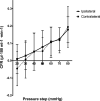Lymphatic Function in the Arms of Breast Cancer Patients-A Prospective Cohort Study
- PMID: 34476161
- PMCID: PMC8386902
- DOI: 10.1097/GOX.0000000000003779
Lymphatic Function in the Arms of Breast Cancer Patients-A Prospective Cohort Study
Abstract
Background: Lymphedema is a highly feared complication of breast cancer treatment, but the underlying complex mechanisms are still unknown. Thus, we investigated the lymphatic morphology and contractility in the lymphatic vessels of arms of high-risk breast cancer patients treated for node-positive early breast cancer.
Methods: In this prospective cohort study 32 women treated for unilateral node-positive breast cancer were enrolled and studied 36 ± 23 days after loco-regional radiotherapy. Near-infrared fluorescence imaging was used to assess morphology and function of the superficial lymphatic vessels. Strain-gauge plethysmography was performed to evaluate the capillary filtration of fluid.Both arms were investigated, with the non-treated arm acting as control. The patients were questioned about the presence of lymphedema yearly and finally 574 ± 118 days after ended radiotherapy.
Results: Morphologically, 25% of the treated arms expressed lymphatic vessel abnormalities compared to the control arms (p = 0.0048). No difference in functional parameters (maximal pumping pressure, p = 0.20; contraction frequency, p = 0.63; contraction velocity, p = 0.55) was found between the treated and control arms. Patients who later developed lymphedema had a difference in velocity compared to those who did not develop lymphedema (p = 0.02). The capillary filtration rate was similar between the two arms (p = 0.18).
Conclusions: Peripheral lymphatic vessels were morphologically changed in the ipsilateral arm in 25% of the patients and patients who later developed lymphedema showed an early increase in velocity. Other functional parameters and capillary filtration were unchanged in this early phase. These discrete changes might be early indicators of later development of lymphedema.
Copyright © 2021 The Authors. Published by Wolters Kluwer Health, Inc. on behalf of The American Society of Plastic Surgeons.
Conflict of interest statement
Disclosure: The Danish Cancer Society, The Foundation of Medical Progress, Butscher Max Wørzner and wife Inge Wørzner’s Memorial Foundation for the benefit of Cancer Research, and Agnes Niebuhr Anderson’s Foundation have all contributed with financial support to this project. The authors have no financial interest to declare in relation to the content of this article.
Figures
References
-
- Bray F, Ferlay J, Soerjomataram I, et al. . Global cancer statistics 2018: GLOBOCAN estimates of incidence and mortality worldwide for 36 cancers in 185 countries. CA Cancer J Clin. 2018;68:394–424. - PubMed
-
- DiSipio T, Rye S, Newman B, et al. . Incidence of unilateral arm lymphoedema after breast cancer: a systematic review and meta-analysis. Lancet Oncol. 2013;14:500–515. - PubMed
-
- Gärtner R, Jensen MB, Kronborg L, et al. . Self-reported arm-lymphedema and functional impairment after breast cancer treatment–a nationwide study of prevalence and associated factors. Breast. 2010;19:506–515. - PubMed
-
- Deo SV, Ray S, Rath GK, et al. . Prevalence and risk factors for development of lymphedema following breast cancer treatment. Indian J Cancer. 2004;41:8–12. - PubMed
LinkOut - more resources
Full Text Sources


